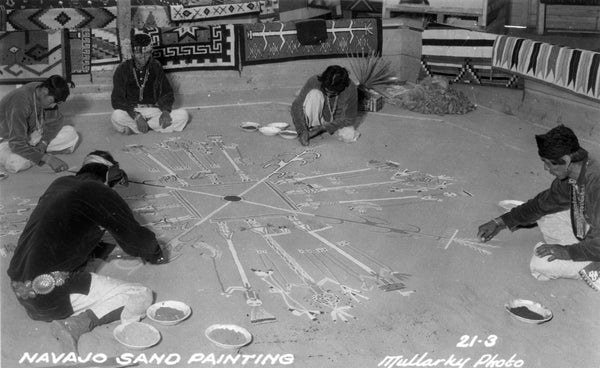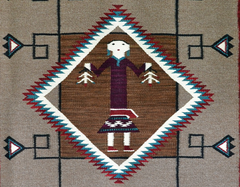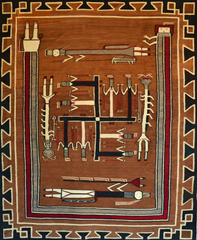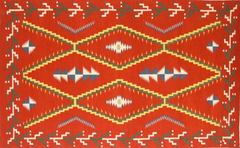Nizhoni Ranch News

New Arrivals
Just a few of the Fresh Pickens From the Res! Check out the link to see the others!
- fiverr fiver

Large Navajo Rugs
Another large Navajo Rug has arrived, just off the loom! Thank You Geraldine Phillips for all your beautiful work !Large Navajo rugs for sale are hard to find. We have the best selection available. Call or email today.
Here is a link to our large catagory
- fiverr fiver

Katherine Marianito – Lady with Courage
Navajo Name: Yiintbaah – Lady with Courage

Born: May 15, 1932
Clans: Redhouse Born for Edge Water (Tabahi)
Chii: Bitterwater, Naali – Nodo dine tachini

Kathy Marianito descends from a long line of some of the finest blanket weavers in Navajo history. A great-great-grandchild of Juanita, considered one of the finest blanket weavers in the 1870-80s, and Manuelito, a prominent leader of the Navajo who helped negotiate their release from Fort Sumner in 1868; she’s inherited a great legacy.
Fortunately, it’s a legacy she’s been proud to represent and has done so quite gracefully. A natural weaver and artist in her own right, she began stealing her mother’s yarn at just 8 years old so she could “weave” it on a nearby fence. Once she was discovered, what began as a difficult challenge quickly became a lifelong passion.
 Her mother would gently push her to learn to do it on her own, with subtle gestures and guidance as she grew more confident in her skills. It wasn’t long before she’d made six blankets in a summer so she could trade them for shoes and clothes for boarding school.
Her mother would gently push her to learn to do it on her own, with subtle gestures and guidance as she grew more confident in her skills. It wasn’t long before she’d made six blankets in a summer so she could trade them for shoes and clothes for boarding school.
Kathy reminds us that it was her mother’s words that were the biggest lesson in our success: “You have to learn it, so you know next time to do it better.”
“My very own hands, my designs…that’s how I got started.”
Before long she learned how to wash sheep’s wool, how to dry it, and how to spin and dye it using plants like sage, sunflowers and tumbleweeds as natural colors. She laughs and says, “We tried everything!”
By 15, however, things began to change and she was to be married in an arranged marriage to an older man. Always the one to strike out on her own path, she instead decided to take off. Taking with some clothes and what little money she had, she rode off on a horse and boarded a bus for Salt Lake City.

The excitement and adventure took hold and for the first time off the reservation, she began educating herself and became a seamstress. She eventually moved on to California, only going back to the reservation for quick visits, stating, “I’d come back to the reservation, but it was lonely because I was a city girl now.” Kathy would laugh.
Years later she did return at the behest of her mother, but she decided to use her newfound time to visit homes and take care of those in the community. While she admits to almost losing her language, it was her people and her mother that brought it and her love for weaving back to the forefront.
As she worked with those going through alcohol detox, she found that a good way to help them stay sober was teaching them different crafts and how to learn new habits.
“I taught grandmothers and young girls to sew and quilt; how to design them; even how to make tools for weaving.” Along the way, Kathy met Lorenzo Marianito, a Navajo medicine man who also came from a family of weavers. This time, however, she found that marriage was the right choice; a decision that has withstood the test of time much like her weavings.
Along the way, Kathy met Lorenzo Marianito, a Navajo medicine man who also came from a family of weavers. This time, however, she found that marriage was the right choice; a decision that has withstood the test of time much like her weavings.
In 1998, Steve Getzwiller heard about Kathy’s beautiful rug-making skills and he convinced her to take her Navajo weaving to a new level. In fact, they were the first to use silk as a fiber in traditional designs, and the only ones incorporating alpaca into their gorgeous, unmistakable art.
Over the next 12 years, Kathy would hone her craft so much so that she became an award-winning weaver. In fact, by 2012, she won many awards including First Place and Best of Category at the Gallup Inter-Tribal All Indian Ceremonial.
Today, her work is highly sought after by collectors and at 85 years young, Kathy still excels in her artwork, the traditions of her past and her present are still there to behold.
She’s quick to recall listening to the tales of her elders, never forgetting the long walk, her search to find herself, while retaining the pride of her people. Kathy Marianito may have ventured out far beyond her mother’s teachings, but each weaving embodies the love she has for her ancestors and her family today.
- jamie getzwiller

The History of Creating Vegetal Rug Dyes
 Weavers have been dyeing the wool for their weavings to create beautiful artistry nearly as long as they’ve been making rugs, tapestries, throws and blankets. And while methods have varied over the years, early Navajo weavers began using natural plant dyes as far back as the 1700s.
Weavers have been dyeing the wool for their weavings to create beautiful artistry nearly as long as they’ve been making rugs, tapestries, throws and blankets. And while methods have varied over the years, early Navajo weavers began using natural plant dyes as far back as the 1700s.
Back then, wool was often dyed using indigo (blue) and cochineal (red)—which was sourced from the English Bayetta wool. Weavers continued to expand their dyeing abilities by boiling plants and extracting even more lasting colors and earthy tones. Today, weavers use a variety of beautiful colors to create gorgeous weavings that are simply breathtaking.
 Vegetal Dyes
Vegetal Dyes
Traditional vegetal dye-making can be a difficult process, especially when trying to achieve the right consistency during dyeing. Weavers use a variety of natural sources to get the right hues and colorations, including roots, berries, flowers, leaves, moss, bark, and even seeds, all of which will vary depending on the growing season.
A fun fact about vegetal dyes: Vegetal dye creation wasn’t an “original” Navajo tradition. The revival of the vegetal dyed blanket began in the 1920s in Chinle with Cozy McSparren and later, Don Jenson in the 1940s. Bill and Sally Lippincott, owners of the Wide Ruins Trading Post, encouraged weavers to use vegetal and native dyes in the 1930s.
By the 1950s, legendary weaver Mable Burnside-Myers of Pine Springs, AZ, created a Navajo Dye Chart to help her children and other weavers create more consistent colors. Her chart shows the following native plants and sources:
- Red Onion Skin
- Sunflower
- Alder Bark
- Sagebrush
- Indian Paint Brush
- Rubber Plant
- Juniper Mistletoe
- Rose Hips
- Small Snake Weed
- Juniper Bark
- Brown Onion Skin
- Gamble Oak Bark
 This resurgence in using native reservation plants has played a major factor in the quality and value of rugs today. In fact, because producing consistent colors and having enough resources can make vegetal dye rugs can be a challenge, the cost of these memorable pieces will continue to rise.
This resurgence in using native reservation plants has played a major factor in the quality and value of rugs today. In fact, because producing consistent colors and having enough resources can make vegetal dye rugs can be a challenge, the cost of these memorable pieces will continue to rise.
Other Notable Dyes and Color Additions
though vegetal dyes are the most widely used and valued among the dyeing formats, there are also two other dyes that should be mentioned so you can properly understand how weavings are colored. These are aniline dyes and blended wools.
Aniline Dye
A synthetic and organic class of dye sourced from coal tar (aniline), these dyes or pigments are generally found in very bright or very dark colors used in Navajo weavings or textiles. Even newer anilines are working to emulate the subtle tones of vegetal dyes.
Blended Wools
When weavers card natural sheep wools and goat fibers together, this can form a new natural color known as a blended wool. For example, if you were to take two different sheep colors (black and white), you could card them together to create soft grays. These are often found in hand-spun rugs.
- jamie getzwiller

Symbols and Motifs in Navajo Weaving
 The Navajo people have a rich history of beautiful traditions that are proudly passed down from generation to generation; many of which can be seen in the gorgeous weavings and tapestries of the Navajo weavers.
The Navajo people have a rich history of beautiful traditions that are proudly passed down from generation to generation; many of which can be seen in the gorgeous weavings and tapestries of the Navajo weavers.
Like most storied cultures, the Navajo believe in powerful deities and forces that have guided them on their path through life; be it traveling by the sun’s rays, learning to live in harmony by Changing Woman, or building a framework for life by using the teachings of Spider Woman.
As such, there are a few very distinct designs, patterns, and motifs that can be found in both past and present weaving styles. Below are just a few of the more iconic and storied traditions used by weavers young and old.
 Spider Woman
Spider Woman
Being that Spider Woman taught the Navajo how to weave, it’s only fitting she dominates much of the early weaving work done by the Navajo people. That’s why many early blankets featured a cross representing Spider Woman and her teachings. Though methods on placement vary, it’s widely considered taboo to place this cross within a diamond, square or triangle pattern so as not to “trap” her in the work; thus, you’ll often find a hole (figuratively or legitimately) woven into the piece.
 Navajo Homeland
Navajo Homeland
Navajo weavers, like anyone proud of their motherland, would often capture elements of the four sacred mountains of the Navajo homeland in their work. From wearing blankets to modern-day rugs, the use of diamonds and triangles have become cornerstones for representing the “Dinétah” and the beautiful land they call home.
 Spirit Line
Spirit Line
At the turn of the 20th century, weavers began to popularize what we now know as the “spirit line.” This developed because traders of the era wanted borders around these weavings and the Navajo weavers were worried this style would trap their creativity and limit the future work. The spirit line then became a thin contrasting line that ran from the inner weaving to the outer edge to ensure that the creative spirit could still be found.
 Whirling Logs
Whirling Logs
One of the most iconic (and controversial) design elements up until the 1930's was the whirling logs design. Often mistaken for the Nazi “swastika”, the logs were originally chosen as a symbol of good luck and represented all things good to the Navajo. As you can imagine, this style didn’t prevail through WWII.
 Lightning
Lightning
A powerful elemental force symbolizing much among the Navajo people, lightning embodies strength and power for the weaver, the culture, and even the weaving itself. These “zigzag” weaving styles are most often found in the Eye Dazzler and Germantown designs, creating gorgeous designs that give each rug or blanket its own fantastic energy.
Other Notable Inspirations
Like many early civilizations, the Navajo weavers were inspired by their unforgettable pasts. Weavers would often find inspiration in pictographs, prehistoric pottery, petroglyphs, and even the natural color palettes around them.
- jamie getzwiller

- Brad Rees
- Tags: News

Picturesque Canyon de Chelly
|
- Brad Rees
- Tags: News















